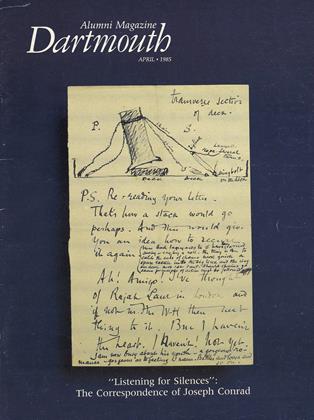JOHN DEERE'S COMPANY: A HISTORY OF DEERE & COMPANY AND ITS TIMES
Professor Wayne G. Broehl, Jr., Doubleday, 1984. 906 pp., $24.95.
Reading history is always instructive, and never more so than when portrayed through the personal experience of those who significantly contributed to its development. The reader then lives in the milieu of the past. Professor Wayne Broehl has succeeded admirably in telling the story of the people who started and built one of America's great enterprises. He has done more: The company's history is a faithful reflection of the unique characteristics of a nation in the 19th-century stage of its explosive growth.
When John Deere left his Vermont blacksmithery to join the wave of migration to the midwestern prairies, he had no thought of changing his trade. How was he to know that the sticky prairie soil would give him his greatest opportunity? But a farming expansion of great importance resulted from his imaginative design of a smooth steel plow that shed the turned soil. Deere's blacksmithing gave way to an activity that started with plows and harrows, then with an amazing line of farm implements, first at home, and in the course of time, internationally. Although by no means the only steel plow, his was among the best. It seeded an organization that, with partners competent in marketing and finance, ultimately built a worldwide enterprise.
After careful research of available records, Dr. Broehl, the Benjamin Ames Kimball Professor of the Science of Administration at the Tuck School, tells this interesting story of early capital formation. There are really two books here the formative years of the last century, and the vicissitudes of the modern corporation in this one. Each period had its special problems, but this reader has been particularly enriched by the 19thcentury experiences. There were many handicaps. Production was crude, delivery of plows was by river and horsedrawn dray to a shifting group of dealers, cash flows and collections were imp aired by inadequate banking and lack of a uniform currency, sales restricted by limited means of advertising. Without central banking, business cycles were more violent and shorter the 1857 crises nearly bankrupted the young partnership. It kept growing and extending its products, but only after its collections difficulties in the mid 1850s had been cured. In 1868 the partnership was finally incorporated. The Civil War had increased the demand for farm produce; larger farms meant more equip- ment; Deere shared in the prosperity. Most of the familiar business problems of our day began to emerge in the last part of the 19th century. Trade ass ociations convened to discuss price stabilization, protest organizations were led by the Granges, innovative changes in marketing established large regional jobbers in which a minority interest was often retained. The product line was expanded and performance improved. Even an attempt at acquisition was made by foreign interests. John Deere's Company was an integrated and contributing part of a nation in a period of rapid growth, with all of the accompanying concerns and successes.
There is one matter that stands in contrast to the contemporary scene, however, on which more analysis would have been appreciated. Studies cited on pages 236 and 226 indicate that in the decades following the Civil War, both the production and productivity of the nation were growing but without the distorting impact of continuous inflation. Moreover, a significant part of the incremental benefits accrued to non farm employees without the current enthusiasm for organized pressure groups a conclusion, if valid, of profound significance.
For those whose primary interest is in the management of the modern business corporation, the 20th century years of John Deere's Company provide an insightful case history. Neatfjnergers, the Great Depression, adaptation to the requirements of World Wars I and 11, the challenge of unionization and the administration of a multinational firm all provide a narrative of the Company's progress to the present time. In Professor Broehl's competent hands, it is a story both fascinating and instructive.
Courtney,. C, Brown is the Emeritus Deanof Business at Columbia University.
 View Full Issue
View Full Issue
More From This Issue
-
 Cover Story
Cover StoryListening for the Silences
April 1985 By Laurence Davies -
 Feature
FeatureMinimum Standards
April 1985 By Gayle Gilman '85 -
 Feature
FeatureKey to Success: Dartmouth's Athletic Sponsor Program
April 1985 By Jim Kenyon -
 Feature
FeatureHistorical Notes on the Upper Valley
April 1985 By Jerold Wikoff -
 Feature
FeatureFROM THE DESK OF THE PRESIDENT
April 1985 -
 Article
ArticleWorth his salt
April 1985 By JOseph Berman '86
Books
-
 Books
BooksWINNING FOOTBALL PLAYS.
February 1955 By CLIFF JORDAN '45 -
 Books
BooksTHE INVASION FROM MARS
June 1940 By Irving E. Bender -
 Books
BooksTHE DARTMOUTH BOOK OF WINTER SPORTS
January 1940 By Nathaniel L. Goodrich -
 Books
BooksUrban Romantics
April 1976 By NOEL PERRIN -
 Books
BooksForm and Message
JUNE 1977 By RUDI BLESH '21 -
 Books
BooksAMATEUR SUGAR MAKER.
APRIL 1972 By RUTH J. WELLINGTON


